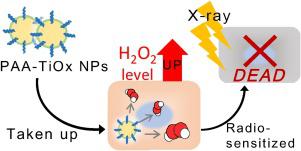Colloids and Surfaces B: Biointerfaces ( IF 5.8 ) Pub Date : 2020-11-07 , DOI: 10.1016/j.colsurfb.2020.111451 Kenta Morita 1 , Yuya Nishimura 2 , Satoko Nakamura 2 , Yuki Arai 3 , Chiya Numako 3 , Kazuyoshi Sato 4 , Masao Nakayama 5 , Hiroaki Akasaka 5 , Ryohei Sasaki 5 , Chiaki Ogino 2 , Akihiko Kondo 6

|
Polyacrylic acid-modified titanium peroxide nanoparticles (PAA-TiOx NPs) are promising radiosensitizers that enhance the therapeutic effect of X-ray irradiation after local injection into tumors. However, the mechanism for this reaction has remained unclear with the exception of the involvement of hydrogen peroxide (H2O2), which is released by PAA-TiOx NPs to a liquid phase during dispersion. In the present study, a clonogenic assay was used to compare PAA-TiOx NPs with free H2O2 molecules to investigate the effect exerted on the radiosensitivity of cancer cells in vitro. A cell-free dialysis method revealed that a portion of the H2O2 adsorbed onto the PAA-TiOx NPs during synthesis could be released during a treatment regimen. The H2O2 release lasted for 7 h, which was sufficient for one radiation treatment procedure. For in vitro experiments, cultured human pancreatic cancer cells took up PAA-TiOx NPs in 10 min after administration. Interestingly, when the cells were washed with a buffer after treatment with either a PAA-TiOx NP or H2O2 solution, the intracellular H2O2 levels remained higher with PAA-TiOx NP treatment compared with the H2O2 solution treatment. Furthermore, the effects of subsequent X-ray irradiation corresponded to the intracellular H2O2 levels. These results indicate that PAA-TiOx NPs are efficient carriers of H2O2 into cancer cells and thus enhance the radiosensitivity.
中文翻译:

二氧化钛纳米放射增敏剂,用于将过氧化氢输送到癌细胞中
聚丙烯酸改性的过氧化钛纳米粒子(PAA-TiO x NPs)是有前途的放射增敏剂,可在局部注入肿瘤后增强X射线辐射的治疗效果。然而,除了过氧化氢(H 2 O 2)的参与外,该反应的机理还不清楚,过氧化氢由PAA-TiO x NPs在分散过程中释放到液相中。在本研究中,采用克隆形成试验将PAA-TiO x NPs与游离H 2 O 2分子进行比较,以研究其对体外癌细胞放射敏感性的影响。无细胞透析方法显示一部分H在合成过程中,吸附在PAA-TiO x NP上的2 O 2可以在治疗方案中释放。H 2 O 2释放持续了7小时,足以进行一种放射治疗程序。对于体外实验,培养的人类胰腺癌细胞在给药后10分钟内吸收了PAA-TiO x NP。有趣的是,当用PAA-TiO x NP或H 2 O 2溶液处理后用缓冲液洗涤细胞时,与H相比,PAA-TiO x NP处理的细胞内H 2 O 2含量仍然较高。2 O 2溶液处理。此外,随后的X射线照射的效果对应于细胞内H 2 O 2的水平。这些结果表明PAA-TiO x NP是H 2 O 2进入癌细胞的有效载体,因此增强了放射敏感性。


























 京公网安备 11010802027423号
京公网安备 11010802027423号